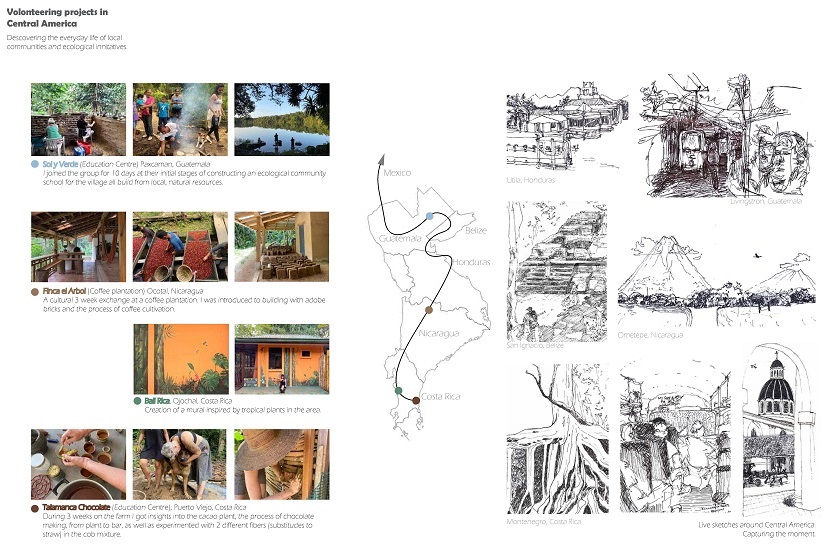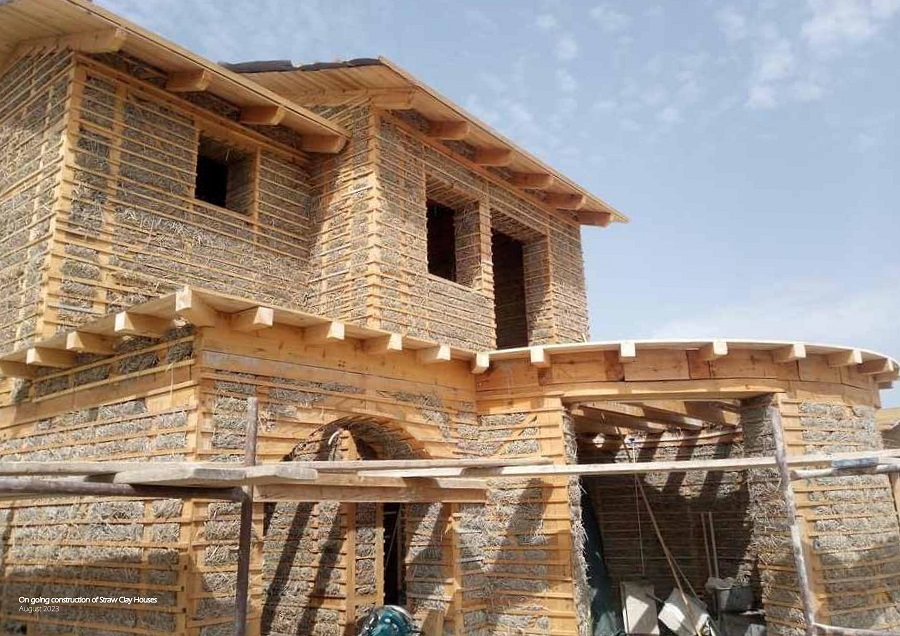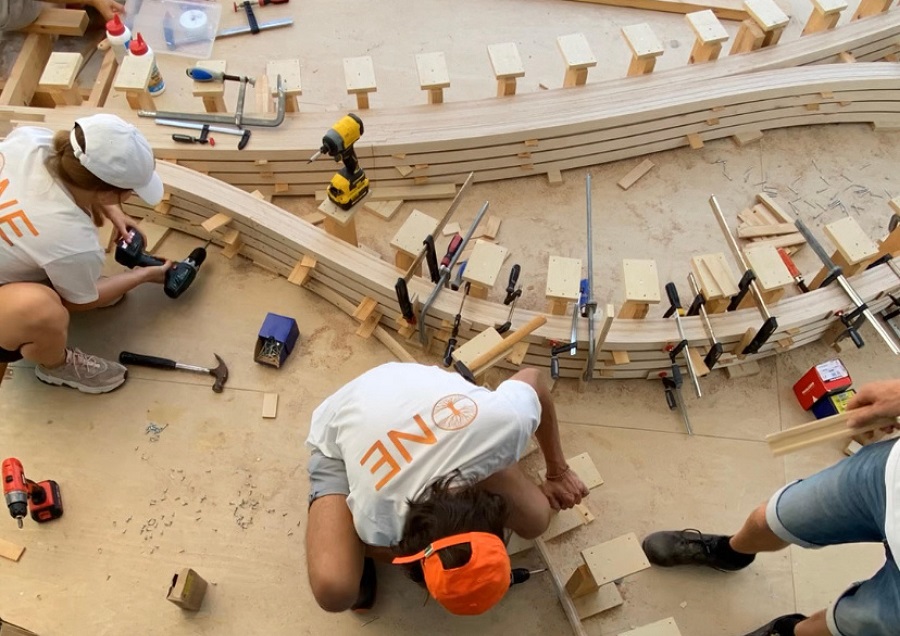From the University of Split in Croatia, the GEN Z Series travels to Oxford Brookes University in the United Kingdom to meet Magdalena Kurdzialek, a 2021 graduated B. Arch young explorer and a passionate architect from Poland. Magdalena reveals, “I was born in Poland. When I was 10, my parents moved to Iran because of work. Later, we relocated to Hungary. I moved to UK to pursue my university education. On completion of my graduation, I undertook a year-long solo adventure through Central America (smiles). When I returned, I completed an internship in Cyprus and currently am residing in Greece. I am a born explorer!”

Temple of the Golden Trees, Cyprus
It is indeed very interesting to explore Magdalena Kurdzialek’s journey into self realization, architecture and her thesis ‘Temple of Golden Trees’ in Cyprus. She enthuses, “Growing up in this nomadic lifestyle exposed me to multitude of cultures, people and education systems. It impacted my sensitivity and broadened my perspective about the world. It shaped my ability to consider matters from various angles. I believe the journey into oneself transcends cultural identifications. As a result, I have developed an ease in adapting to newer environments and finding common ground with myself and people around me (smiles).”
Johnny D talks to Magdalena Kurdzialek about her various experiences and volunteer work, even before she embarked on a professional journey as an architect of the future.

Opening Day, October 2023
What was your childhood ambition? Did you always wanted to become an architect?
As a kid, I wanted to be a dancer. I loved to draw, paint and sculpture. I really enjoyed Maths in school. I was finding my language for self-expression. It was during my GSCE’s, while discussing options with my mother, the combination of my artistic and problem-solving inclinations led me to consider architecture. Initially, I did not fully grasp the abstract nature of this profession.
However, during my IB – International Baccalaureate, it all ‘clicked’ when I watched a TED talk that inspired me to write a psychology paper on the therapeutic aspects of architecture. This realization led me to pursue my Bachelor’s degree at Oxford Brookes University.

Construction Process
How has architecture influenced your life as a student?
Well, I spent a lot of time in the studio. It was a place to laugh, create and complain. I felt a sense of community there. The course gains a lot of respect on campus. Although, I think it is easy to get confined within architecture. It is a demanding course that taught me resilience, performing well under pressure and handling criticism. Your creative ideas are constantly being challenged within an audience. I learnt how much one can get done in one night (Smiles). I think the most challenging time was during the pandemic. I had to return to Poland that is when the feeling of isolation and lack of the studio environment impacted me the most.

First-standing Columns
As an Intern at Office for the New Earth, what role did you performed?
I joined ONE on the construction site of a therapeutic child-friendly space for the refugee community at the Asylum Centre in Kofinou, Cyprus. Both Nills and Micheal, who are the Co-founders of the NGO, were teaching us all the necessary carpentry skills. We were also thinking of technical solutions, design ideas for play elements and creation of graphic content. It was also a pleasure to co-create and execute creative workshops with the kids, and engaging them into the design. We were all working together at the site as a small group of 4-6 people.

Exploring the Space
Looking at the finished product I was proud of everyone involved. The four months on site provided me with a profound understanding of how architectural design comes together through various stages. It challenged my previous perception of architects as mere visionaries. But, here I was really building the space. It was a demanding, yet incredibly fulfilling experience!

Precious Moments with the Kids
Describe the significance of the project you were part of ‘Temple of the Golden Trees’?
What truly resonated with me was the uplifting impact our work had on the children and their families, as well as the atmosphere of the camp. Witnessing the joy that the space brought filled me with a deep sense of fulfilment. ‘You are making the children happy’, said a Somalian girl to us, who often had many insightful comments about the playground. I recall people entering the finished space in awe, followed by feedbacks like ‘Beautiful’, ‘Amazing work’, ‘Thank you’!

Play Elements within the Space
I understood the importance of providing to not only children, but also a given community a safe and nurturing environment. This was another example where architecture ‘clicked’ for me yet again. Through architectural design life can flourish. I believe that the use of natural materials, such as wood and the biophilic design keep the experience grounded, evoke curiosity and allowed to reconnect with one-self. We often played with the kids, when new elements were being installed. I shall cherish those precious moments and laughter that I had shared with everyone around us. I hope the space continues to bring joy to many in coming years. It is a sense of fulfilment that still lingers in my heart even today.

ONE site, Cyprus
Briefly elucidate your three experiences as a volunteer architect.
In Central America, I embarked on a journey driven by my curiosity to understand alternative ways of living. I was getting involved with ecological initiatives within local communities and the aspects of building with earth. During this time, I met passionate individuals dedicated to advocating for change, thereby fostering a strong sense of community.

Creative Workshops with Kids
As a volunteer, I participated in initiatives such as Finca el arbol, a coffee plantation in Nicaragua, Sol y Verde, an organization in the Guatemalan rainforest teaching permaculture and bio-construction practices to woman and children in rural communities. When I returned to Europe, in Kefalonia, Greece, I learned about working with biomaterials through straw clay construction with COB organization.
These diverse experiences showcasing the multitude of possibilities for involvement and sparking my passion for biomaterials and community engagement inspired me.

Central America Volunteering Projects
Which National or International architect has inspired / influenced you? Please specify as to why?
I think it all started with Gaudi, entering Sagrada Familia, when I was 16 during a school trip. His plays, mastery of organic forms and innovative structural details pushing the boundaries of architecture throughout time expanded my understanding of possibilities of architectural design. I am currently very inspired by humanitarian architects such as Yasmeen Lari, her term ‘Barefoot Architecture’, or Anna Heringer and the empowerment of communities and utilization of locally sourced natural materials and techniques.

Straw-Clay Construction
Will the younger generation of architects make innovative changes to mitigate the catastrophic effects of Climate Crisis? Elucidate your perspectives.
I think change is inevitable. Either we are consciously moving towards this goal, or we will be drastically forced to make a choice. Over the years, each generation and each society faced different struggles and therefore acted accordingly to move beyond, grow and survive. So will our generation as we continue creating new models. I strongly believe that the innovative changes do not rely on innovative technology, but consists of changing individual lifestyle to a more simple, natural and conscious one.

Straw-Clay Houses
Which significant aspects of the global platform ‘zerobeyond – the new frontier!’ did you liked the most, and why?
I appreciate that ‘zerobeyond – the new frontier!’ is ultimately about people, giving them the platform to share their perspective on the world, integrating the vastly intriguing topics of architecture, interiors and engineering. Here you can come across the life story of many great designers and young architects alike, who are renowned, established and commencing their journeys in this competitive field respectively. It is a pleasure to share my journey here.

Laminating Tree-like Columns
Local charm of cities has diminished due to Modern Architecture as every city looks alike and similar. How should architects / urban planners / landscape architects modernize cities, while maintaining the local charm intact?
Preserving the local charm of cities requires us to consider their origins and heritage. This includes looking into locally sourced materials and engaging with local artisans, creating architectural pieces that are meant for the community, and simultaneously their involvement in the process. Through various workshops and events, where one is allowed to share their design ideas, I think that is when individuals are personally involved having contributed to the creation, the value of that space within the community increases, giving a sense of ownership and pride.

Natural Building Course
Looking at the past in the current present, what are the futuristic architectural changes you would like to see in your home city / town – Elucidate the reasons for your vision.
This is a harder one for me to elaborate on, as it has been a while since I have spent more time in my home city, which is Warsaw. However, I believe it all comes down to bringing the local charm, artisans and local materials back into the city, showcasing the richness of Polish culture. I support small-scale initiatives and pop-up installations that actively engage the public in the design process.

The Blue House
I believe that public squares can serve as a great space for such engagements. When people are actively involved in shaping their surroundings, they develop a stronger connection to their city and feel a sense of responsibility towards its upkeep and improvement.

Finca el Arbol, Nicaragua
Image Courtesy: Magdalena Kurdzialek